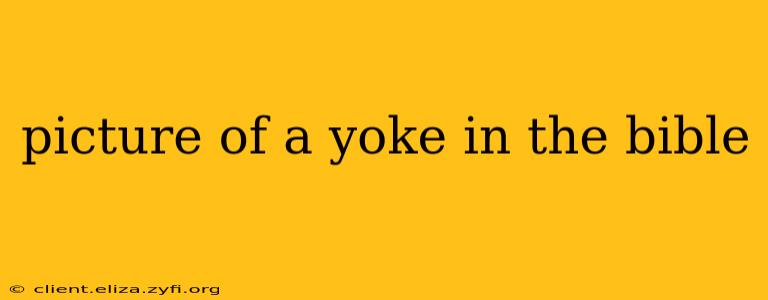The Yoke in the Bible: Symbolism, Significance, and Interpretations
The image of a yoke appears several times throughout the Bible, carrying with it a rich tapestry of symbolic meaning. Understanding its context within different passages reveals its multifaceted representation of burden, servitude, and ultimately, God's grace and provision. This article delves into the various biblical uses of the yoke, exploring its significance and answering some frequently asked questions.
What is a yoke, and what is its significance in the Bible?
A yoke, in its literal sense, is a wooden beam used to connect two oxen, enabling them to work together to plow a field. This simple agricultural tool became a powerful metaphor used by biblical authors to convey complex spiritual and social realities. The yoke symbolizes the burden or responsibility one carries, whether it's imposed externally or willingly accepted.
What does the "yoke of slavery" mean in the Bible?
The "yoke of slavery" refers to the oppressive burden of bondage, whether physical or spiritual. Examples include the Israelites' enslavement in Egypt (Exodus) and the spiritual oppression caused by sin and disobedience. This yoke represents hardship, limitation, and a lack of freedom. It highlights the weight of transgression and the consequences of rejecting God's will.
What does Jesus mean when he says, "Take my yoke upon you"?
Matthew 11:28-30 contains Jesus' famous invitation: "Come to me, all you who are weary and burdened, and I will give you rest. Take my yoke upon you and learn from me, for I am gentle and humble in heart, and you will find rest for your souls. For my yoke is easy and my burden is light." This passage contrasts the heavy yoke of the law and the world's burdens with the gentle and liberating yoke of Jesus. It's not about adding another burden but rather a profound shift in perspective. Jesus' yoke signifies his leadership, his guidance, and the grace and strength he offers to carry the weight of life's challenges. His yoke is "easy" and his burden "light" because He provides the power and support to bear it.
What is the difference between a heavy yoke and a light yoke in the Bible?
The contrast between a heavy and light yoke embodies the difference between oppressive burdens and liberating grace. A heavy yoke represents the weight of sin, the demands of the law, and the pressures of the world, leading to exhaustion and despair. A light yoke, in contrast, signifies the peace, freedom, and grace found in a relationship with Jesus Christ. It's about finding rest in His love and trusting in His strength to carry life's difficulties. This lightness isn't the absence of challenges, but rather a change in perspective, finding strength and purpose in surrendering to God's will.
What are some examples of yokes in the Bible?
Besides the prominent example in Matthew, other biblical instances illustrate the yoke's significance. The Old Testament depicts the yoke as a symbol of servitude and oppression, particularly concerning Israel's relationship with foreign powers. Conversely, the New Testament emphasizes the contrasting yoke of Christ, offering rest and freedom from the burdens of sin and worldly anxieties.
What is the symbolic meaning of the yoke in Isaiah?
Isaiah's prophecies often utilize the image of the yoke to represent judgment, captivity, and the consequences of disobedience. Conversely, it also signifies restoration and deliverance when God breaks the yoke of oppression and releases His people from bondage. The imagery emphasizes God's power to both inflict and remove burdens.
In conclusion, the yoke in the Bible is far more than a simple agricultural tool; it's a potent symbol representing diverse concepts ranging from oppression and burden to grace, freedom, and the transformative power of faith in Jesus Christ. Its varied applications across different books and contexts highlight its enduring relevance as a metaphor for spiritual and emotional realities. Understanding its use within the narrative provides deeper insights into the biblical message of hope, redemption, and the promise of eternal rest.
